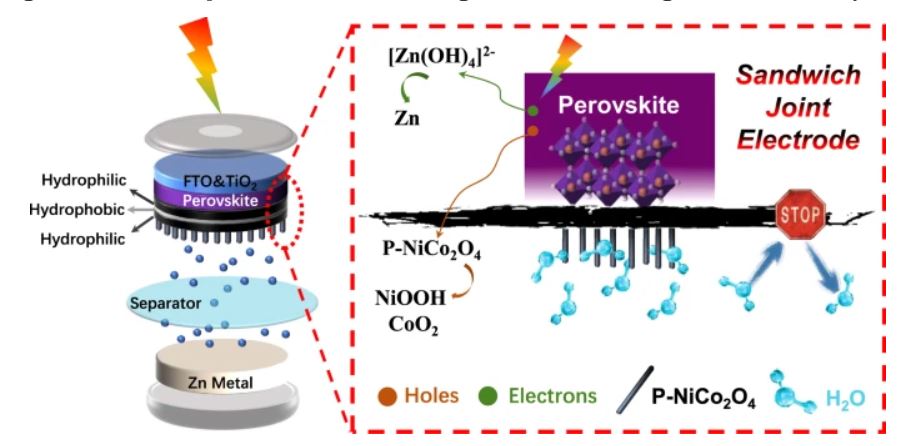From pv magazine Global
Scientists from the Nankai University in China have fabricated an integrated solar rechargeable zinc battery (SRZB) powered by perovskite solar cells that could be used for wearable smart electronics, Internet of Things (IoT) devices, and other electrically powered equipment.
The system was built in a 4-layer configuration including a perovskite light absorber, a sandwich joint electrode, an aqueous alkaline electrolyte, and zinc metal. “Benefiting from the integrated device structure, specially designed components and narrow-range voltage-matching mechanism, our inexpensive SRZB shows remarkably high specific energy, high specific power, high safety and high overall efficiency,” the researchers stated.
The sandwich joint electrode was embedded in the device to integrate the aqueous zinc battery with the water-sensitive perovskite solar cells. “Intrinsically, the sandwich joint electrode possesses a hydrophilic-hydrophobic-hydrophilic structure feature, which ‘hides’ the impermeable protective layer internally and exposes two external hydrophilic interfaces to simultaneously achieve protection and electrical performance,” they further explained.
One of the two hydrophilic sides of the electrode was doped with nickel cobaltite (NiCo2O4) to improve its compatibility with the other layers, while the other side acts as the counter electrode of perovskite solar cells to obtain better interfacial contact.
The electricity generated by the perovskite solar cells is fed into the fluorine-doped tin oxide (TiO2/FTO) substrate and is transferred to the Zn electrode to reduce zinc ions. Holes can then spread through the sandwich joint carbon layer to achieve an oxidation reaction on the positive electrode. “In this way, the SRZB can harness the infinite power of solar irradiation and store this solar energy in terms of electrochemical energy,” the Chinese group stated. “The as-stored electrochemical energy can be subsequently released with controllable and steady output according to the demand.”
After measuring the system performance, the scientists found it can achieve high specific energy of 366 Wh/kg, high specific power of 54.01 kW/kg, an overall efficiency of 6.4%, and a steady operation for more than 200 cycles with little performance degradation. “High safety and low-cost demands are also satisfied owing to the use of cost-effective materials, a safe aqueous electrolyte and a special photocharge mode,” they concluded.
The device is presented in the paper Coupling aqueous zinc batteries and perovskite solar cells for simultaneous energy harvest, conversion and storage, published in nature communications.
This content is protected by copyright and may not be reused. If you want to cooperate with us and would like to reuse some of our content, please contact: editors@pv-magazine.com.









By submitting this form you agree to pv magazine using your data for the purposes of publishing your comment.
Your personal data will only be disclosed or otherwise transmitted to third parties for the purposes of spam filtering or if this is necessary for technical maintenance of the website. Any other transfer to third parties will not take place unless this is justified on the basis of applicable data protection regulations or if pv magazine is legally obliged to do so.
You may revoke this consent at any time with effect for the future, in which case your personal data will be deleted immediately. Otherwise, your data will be deleted if pv magazine has processed your request or the purpose of data storage is fulfilled.
Further information on data privacy can be found in our Data Protection Policy.